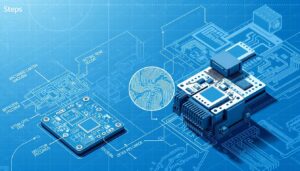Whether in mechanics, software or hardware, reverse engineering enables detailed analysis of system architecture and functionality. It supports interoperability by revealing undocumented protocols and formats. Engineers gain insights to improve performance, security, and design. It drives novel approaches based on existing technologies. Too frequently seen as software cracking, it emphasizes understanding and innovation, not always exploitation.
Disclaimer: this content is for educational product design purposes only and does not encourage or endorse unauthorized reverse engineering. While we see benefits for innovation so as for legacy products maintenance and ecology, reverse engineering may violate software licenses, terms of service, or intellectual property laws depending on your jurisdiction. Always consult a legal professional before engaging in any reverse engineering activities.
Reverse Engineering in Electronics
Reverse engineering in electronics is about taking apart a mix of many small components, their assembly, so as potentially embedded software or logic to learn how it works. It’s key in fields like cars, gadgets, and big machines. Sometimes, the details on tech are hard to find or locked away. Through reverse engineering, pros can copy, make better, or fix tech projects. They make sure these meet today’s needs and rules. This piece digs into how reverse engineering in electronics works, its steps, and what tools folks use.
|
Applications of reverse engineering in electronics Electronic reverse engineering has many uses across different sectors, such as:
|
Tools for reverse engineering in electronics Key tools and methods include:
Although not seen yet at an industrial scale, it is predictable that automatic vision recognition and AI will change this field soon. |
The Hardware RE Process

The reverse engineering process includes many steps for a deep look into electronic hardware. Every stage helps gain a full understanding of the device, focusing on all important parts:
- Initial assessment and observation: reverse engineering starts with a close look at the hardware, noting how things connect and are set up. This might involve looking at big connectors for important interfaces. They also pay attention to marks that give clues about the board’s design and use. Figuring out the power circuits, integrated circuits (ICs), and how it communicates is key.
- Identifying circuit components: after the first look, identifying each circuit part comes next. Engineers take the device apart and label everything. This helps them understand what each piece does, like resistors, capacitors, and ICs. By keeping track of these parts, engineers can analyze the hardware better. This lets them see how each component fits in the whole system.
- Creating schematics: the last step is to make schematics that show the circuit’s layout. Engineers use info from earlier to draw detailed diagrams. These schematics make the reverse engineering process clear, showing how parts connect and interact.
Reverse Engineering in Software
Reverse engineering is fascinating to many fields, showing its wide use. It’s big in the area of software analysis, where the goal is to understand how current applications work. By disassembling software, experts learn about how it functions and why certain designs were chosen.
In fixing bugs, developers turn to reverse engineering. It helps them find and solve problems in software. This way, they can spot mistakes that aren’t obvious with regular debugging methods. By finding weak spots in famous apps, or offering incentives for this, they can build stronger defenses to protect user info.
Game creators also see benefits in reverse engineering. They study successful games to see what players like. Then, they add those popular elements to their own games to make them more fun.
This practice is becoming more important for analyzing software. It’s critical for fixing problems and planning new strategies. Reverse engineering is a key technique in our modern world of quick tech changes.
|
Key Steps Involved Several steps are part of the process:
|
Tools for software reverse engineering Several important steps are part of the reverse engineering process. They include:
|
Static vs. Dynamic Analysis

Developers and security experts mainly use two types: static analysis and dynamic analysis.
- Static analysis means looking at the software without running it. Analysts can go through the code, spot weak points, and get the big picture of the program. They dig into the code or binaries to learn about how the software works. This way, they can find hidden issues or security risks.
- Dynamic analysis, on the other hand, is about running the software to see how it acts. It lets experts see the software’s interaction with its surroundings, showing real-time data, execution paths, and user actions. By watching how the software works, analysts understand it better, noting how it uses memory and...
You have read 41% of the article. The rest is for our community. Already a member? Log in
(and also to protect our original content from scraping bots)
Innovation.world community
Login or Register (100% free)
View the rest of this article and all members-only content and tools.
Only real engineers, manufacturers, designers, marketers professionals.
No bot, no hater, no spammer.

























